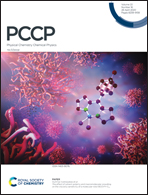Remarkable Rashba spin splitting induced by an asymmetrical internal electric field in polar III–VI chalcogenides†
Abstract
Herein, the Rashba spin orbit coupling (SOC) of polar group III–VI chalcogenide XABY (A, B = Ga, In; X ≠ Y = S, Se, Te) monolayers is investigated based on density functional theory. The different electronegativities of X and Y atoms lead to an asymmetrical internal electric field in the XABY monolayer; this implies that the internal electric field between A and X is not equal to that between B and Y. Mirror symmetry breaking in the XABY monolayer induces a remarkable Rashba spin splitting (RSS) at the conduction band minimum (CBM). Moreover, it is demonstrated that an external electric field and an in-plane biaxial strain can affect the internal electric field by varying the charge distribution, and this further manipulates the RSS. Under a positive external electric field and tensile strain, the RSS at the CBM exhibits a near-linear increasing behavior, whereas under a negative external electric field and compressive strain, the RSS displays a monotonous decreasing pattern. In addition, we explored the influence of interlayer coupling and substrate on the RSS. The stacking pattern of bilayer structures has a significant impact on the RSS. The investigation of SInGaSe on the Si(111) substrate suggests that the Rashba band is situated inside the large band gap of the substrate. Overall, our investigations suggest that the polar group III–VI chalcogenides are promising candidates for future spintronic applications.



 Please wait while we load your content...
Please wait while we load your content...